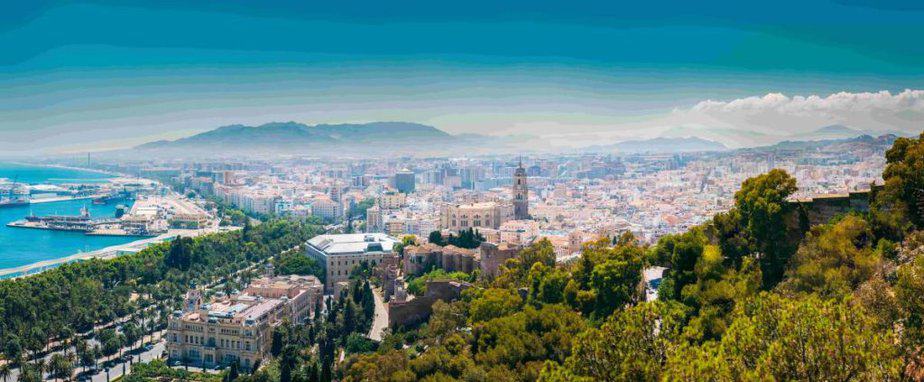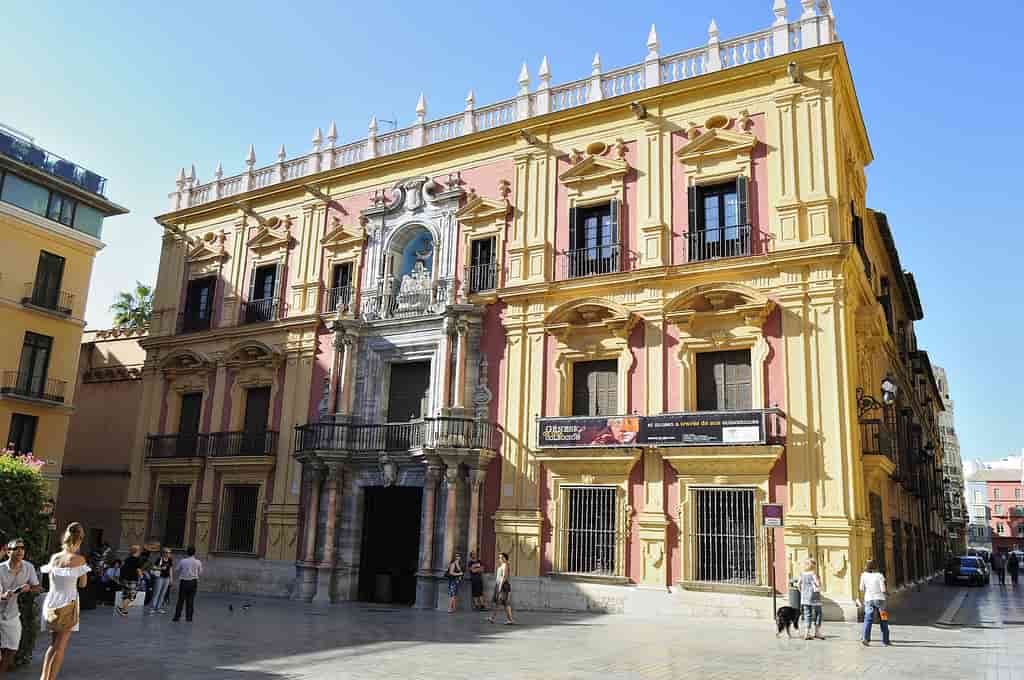Deprecated: mb_convert_encoding(): Handling HTML entities via mbstring is deprecated; use htmlspecialchars, htmlentities, or mb_encode_numericentity/mb_decode_numericentity instead in /home/u211400686/domains/tripinspain.com/public_html/wp-content/themes/acabado/functions.php on line 2160
Malaga’s beaches, cuisine, and history are why you should visit. Whether you’re looking for a solemn visit to the Alcazaba fortress or a lighthearted visit to the Picasso Museum, you’ll find it all in this stunning Andalusian city. Learn more about the top attractions in Malaga and where to stay below. Keep reading to find out why Malaga is a must-see for travellers of every experience level.

Content
- Picasso Museum Málaga
- Catedral de la Encarnación de Málaga
- The Alcazaba of Malaga
- The Malaga Gibralfaro Castle
- Casa Consistorial
- Teatro Romano de Málaga
- Plaza de Toros “La Malagueta”
- Palacio Episcopal
- Jardin Botanico-Historico “La Concepcion”
Visitors to Gibraltar often stop by the Alcazaba Citadel and the Gibralfaro Hilltop Potential Fortification Site. Both of these places are perched on a ridge. However, the Picasso Museum at the Buenavista Palace is to be noticed if you ever find yourself in Malaga. A current exhibition by a Malaga-based artist is must viewing.
Picasso Museum Málaga
The Buenavista Palace houses the Pablo Picasso Museum (Museo Picasso de Malaga) in the Jewish quarter, not far from where the artist was born. This museum is one of six in Spain dedicated only to Picasso, and it features his art from his early years right up to his surrealist phase.
The museum is housed in what was once the Buenavista Palace, which served as the monarchy’s official residence. Precisely fifty years after Malaga was conquered, in 1530, its king, Diego de Casaglia, ordered its construction. After being owned by a string of different families, this palace eventually opened to the public as a museum in 2003.
Over 200 of Picasso’s paintings are housed in the Picasso Museum, spanning his early works through his most current surrealist works. Picasso’s grandson and daughter-in-law gifted the museum most of their personal collection.
This was the first from our list of Attractions in Malaga.
Address: C / San Agustin 8, 29015 Málaga
Opening hours: from 10:00 to 20:00 (Friday and Saturday until 21:00 h.). Closed Monday.
In July and August, the museum is open on Mondays from 10:00 to 20:00.
Buy tickets: Museo Picasso Málaga: Ticket & Audioguide

Catedral de la Encarnación de Málaga
It takes ten minutes to walk from the Church of John the Baptist to Malaga’s Cathedral (La Catedral de la Encarnación) and ten minutes further to go southwest to the Church of the Holy Martyrs. If you visit Andalusia, don’t miss this church, which is the region’s crowning Renaissance architectural achievement. Located inside the original fortifications, it is part of a larger architectural complex that also includes the Gibralfaro fortress and the Alcazaba.
According to Diego de Siloé’s blueprints, construction on the cathedral took place between 1528 and 1782. The Baroque cathedral has a double-tiered façade. It has three arches at its base, which lead into rooms separated by marble columns and arched doorways. A medallion depicting the Annunciation graces the middle door, while those of Saints Paula, Malaga, and Kyriakom adorn the outer doors.
This was the second from our list of Attractions in Malaga
Address: C / Molina Lario 9, 29015 Málaga
Opening hours: Friday to Monday – 10:00 am to 6:00 pm
10:00 a 17:00 on Saturday
Book now: Málaga: Cathedral, Alcazaba, Roman Theater Walking Tour

Alcazaba
The strong and high walls of the Alcazaba were built in the 11th century and still adorn the city, being one of the most interesting architectural monuments not only in Malaga but also in Spain as a whole. The Alcazaba is located on the coastal hills; it still attracts attention from a distance with its grandeur and picturesque appearance; from its peaks, there is a beautiful view of the large port and the entire Malaga bay with beaches and hotels.
According to Islamic traditions, the Alcazaba was built between 1057 and 1063 by Badis ben Abus, the Berber king of Granada. Marble and columns with capitals from the neighbouring Roman theatre were utilized in the building. The Almoravids seized the Alcazaba in 1092, followed by the Almohads in 1146.
Muslims
To get to the most elevated part of the palace, where the city mayor or qadi lived (in Muslim countries, this is a judge who administers justice according to Sharia law), you would have to overcome three levels of ring fortifications, as well as eight fortified gates. Additionally, the walls were protected by battlement towers and loopholes. All these fortifications protected the inhabitants of the Nasrid Palace (the last ruling Spanish Muslim dynasty) and all the townspeople who lived inside the city walls. The towers were reconstructed several times (before and after the Christian conquest of the city).
In the citadel, there is also an archaeological museum with reconstructions of the Alcazaba before. After multiple restorations, pottery from the Moors and Spaniards and different ancient items were discovered amid the Roman remains.
This was the third from our list of Attractions in Malaga
Address: Avinguda Diagonal 209-211.
How to get there: Glories metro station (line 1), tram, or bus
Book now: Málaga: Cathedral, Alcazaba, Roman Theater Walking Tour
Here you can find more information about Alcazaba…

The Malaga Gibralfaro Castle
Mount Gibralfaro (142 m) was once the location of a Phoenician fortification with a lighthouse; the Arabic name for the peak, Jabal Faro, translates to “lighthouse on the cliff.” The intended goal of this fort, which was linked to the Gibralfaro castle by a peculiar transition, was the Alcazaba fortification, which was located immediately below the slope.
Gibralfaro Castle, or Castillo de Gibralfaro, is protected by two sets of zigzag walls (called coach) topped by turrets and battlements. The stronghold can comfortably house 5,000 soldiers because of its spacious interior. Gardens full of eucalyptus and cypresses, orange and pomegranate trees, focuses and olive trees surround the fort, which is reached via a picturesque pine corridor. From the Gibralfaro fortress, you can see the entire city of Malaga and its harbour, Gibraltar’s Strait and the Reef’s African mountains.
The Bottomless Well was carved into the rock during the Arab era and had a depth of roughly 40 meters; it joins the two bakeries, different springs, current castle towers, and the structure that used to house a powder flask, which is now utilized as a concert hall, as notable landmarks.
This was the fourth from our list of Attractions in Malaga
Address: Paseo de Reding, 1.29016 (Málaga)
Opening hours: In the summer, from 9:00 to 20:00. In winter, from 9:00 to 18:00.
Book now: Malaga: 3-Hour Historical Segway Tour (They will bring you to the Gibralfaro Castle)

Casa Consistorial
From 1912 to 1919, the Casa Consistorial served as the city’s town hall. Indeed, it is rightly regarded as one of Malaga’s most stunning modernist works. The Town Hall is a beautiful representation of the neo-baroque and art nouveau styles.
The structure features a stunning plenary room and a mirror room. The municipal building and the adjacent Pedro Luis Alonso Garden, the work of renowned architect Fernando Guerrero Rosado Strachan, were designated national historic landmarks in 2010. Statues depicting seafarers, fishermen, and merchants line the halls. In addition, famous 20th-century painters and forward-thinking postmodernists have had exhibitions in City Hall’s grand entrances.
This was the fifth from our list of Attractions in Malaga
Address: Av. Cervantes 4, 29016 Málaga

Teatro Romano de Málaga
The Roman Theater of Malaga may be found in the city’s Calle Alcazabilla, just below the Alcazaba. The theatre was uncovered in 1951 during the construction of the House of Culture; ironically, it was constructed directly over the performing arts centre. The demolition of the House of Culture and the excavation of the Roman Theater began in 1994.
The theatre was built in the first century BC. e., at that time, Malaga was part of one province of the Roman Empire; it was called Far Spain. The theatre was built under Octavian Augustus and was used until the 3rd century AD. NS. During Muslim rule, the theatre was used as a quarry for rebuilding the Alcazaba: the columns and capitals of the theatre were used as mountings for horseshoe-shaped arches at the gate of the Alcazaba.
This was the sixth from our list of Attractions in Malaga
Address: C / Alcazabilla 8, 29012 Málaga
Working hours: from 10:00 to 18:00. Day off – Monday
Book now: Málaga: Cathedral, Alcazaba, Roman Theater Walking Tour

Plaza de Toros “La Malagueta”
The huge bullring (Plaza de Toros “La Malagueta”) is famous in Malaga. It was built in 1876 by the Spanish architect Juaquin Rucoba in the neomudejar style. The arena accommodates about 9 thousand visitors.
The Plaza de Toros is featured on every second souvenir postcard. As a rule, the bullfighting season starts in spring, during Holy Week, and continues until the end of September. Therefore, booking your tickets online is best to avoid the tedious queues under the scorching sun.
The price range continuously varies depending on the importance of the event. The location of the seats is also of great importance – a ticket to a grandstand in the shade, for example, will cost twice as much as a seat on the sunny side.
Address: Paseo Reding 8, 29016 Malaga
Working hours: Monday – Friday from 10:00 to 13:00

Episcopal Palace
The Episcopal Palace, or Palacio Episcopal, in Malaga was built in the 18th century. The Baroque building is expansive, with many levels, balconies, and stairways. But the diocesan museum of spiritual art is where true history lovers will want to spend their time.
Between 1500 and 1525, Bishop Diego Ramirez Villanueva de Aro constructed the first bishop’s palace. However, the palace’s inadequate size led to the 1541 decree for a new castle to be built where modern-day Santa Maria Street sits.
Address: Pl Obispo 6, 29015 Malaga
Opening hours: Tuesday from 14:30 to 20:00,
Wednesday – Saturday from 10:00 to 20:00,
Sunday from 10:00 to 14:00.

Jardin Botanico-Historico “La Concepcion”
The Malaga Botanical Garden (Jardin Botanico-Historico “La Concepcion”), which has existed for more than 150 years, is one of the English-style gardens. More than 3,000 distinct tropical plant kinds thrive here; they were imported from India, Mexico, Japan, and Australia and harvested from across Spain. Each plant has a separate sign that provides its name, country of origin, and age to make it easier to explore the garden.
Address: Cmno Jardin Botanico del 3, 29014 Málaga
Opening hours: Monday to Friday from 8:00 to 15:00.
This was the last from our list of Attractions in Malaga

Check our post: Best ten things to do in Malaga in 2023
